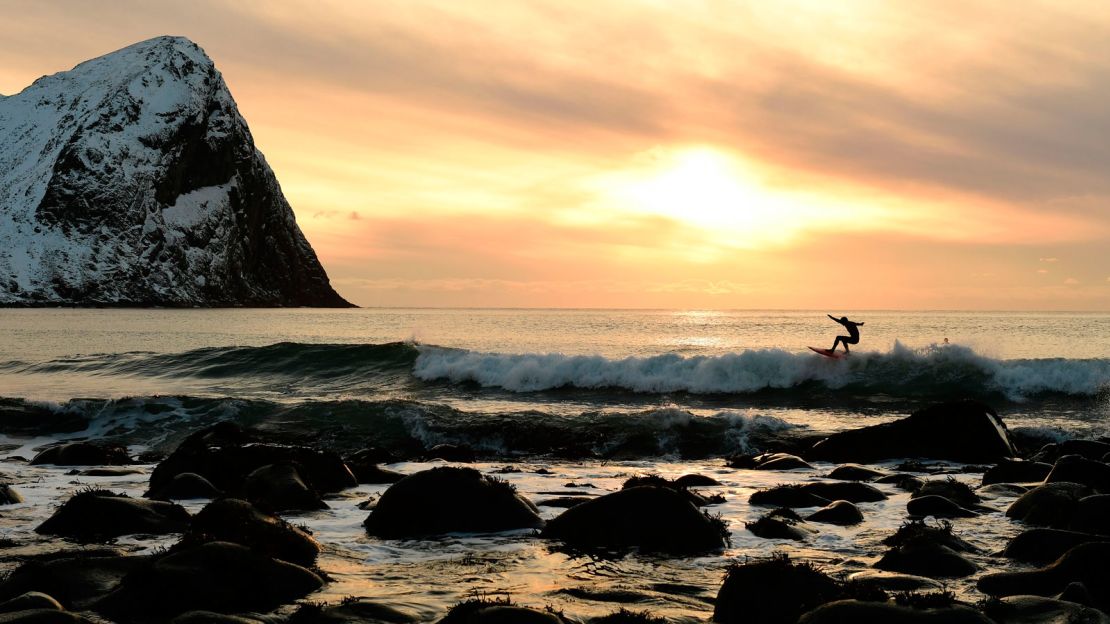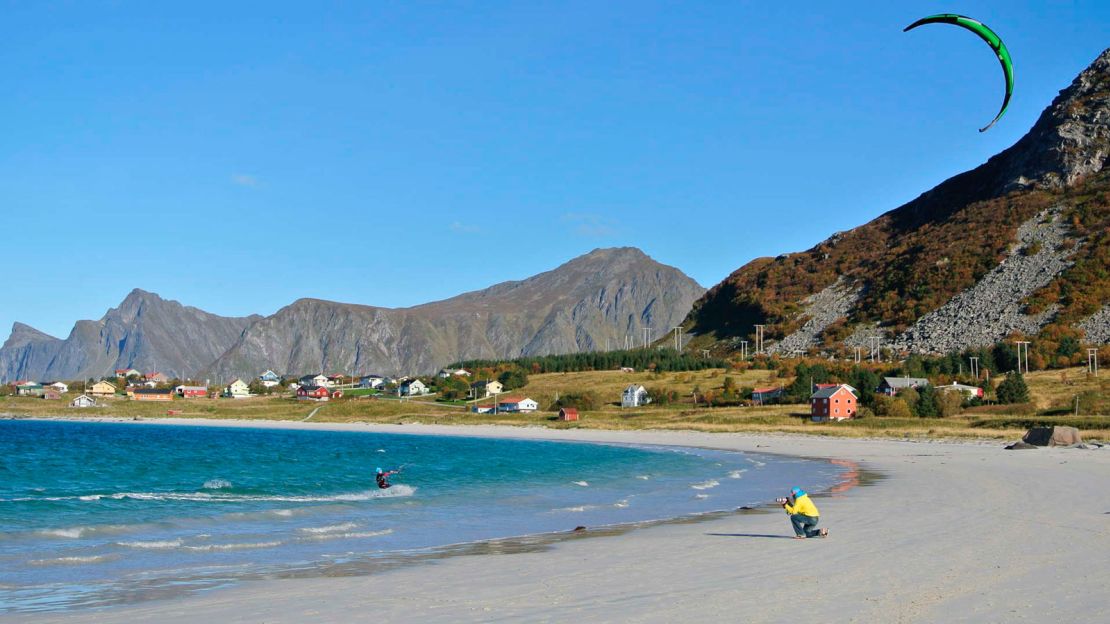Northern Norway may not spring instantly to mind for those planning a beach vacation. Yet the golden sands of the remote Lofoten Islands draw photographers, surfers and backpackers from the world over.
A road trip along the narrow roads of Norway’s Lofoten Islands inevitably takes hours longer than planned. Around every bend there’s another breathtaking vista, an even more dramatic mountain, or yet another fishing village of red wooden huts that just begs to be explored.
For those who venture off the E10, one of Norway’s 18 designated National Tourist Routes, Lofoten’s secrets are worth discovering.
While the islands are best known for their spiky landscape, idyllic waterside villages, Northern Lights displays and world-class hiking, it’s the beaches that are the biggest travel surprise.
A mild climate
The islands enjoy an oceanic climate far milder than their latitude would suggest. In fact, the temperature is most often compared to that of Seattle or Quebec City, which lie 20 degrees farther south on the globe.
Locals make the most of the climate anomaly by heading to the beaches on sunny days, yet with ice-cold water and few facilities it doesn’t attract the typical beach-seeker. Backpackers, hikers, photographers and surfers are the new Lofoten tourists.
The seaweed-strewn sands, jagged mountain peaks and large boulders fading into the waves create a dramatic setting for watersports and filmmakers alike.
While the summer offers a mild climate for camping, many photographers hope to strike it lucky with a Northern Lights show, most likely to occur in late winter or the fall. More still come to capture the beauty of the coastline after a snowfall.
A world-famous surfing destination

Unheard of by most Norwegians, Unstad Beach is a name familiar to cold-water surfers around the world.
Since 2007, the Lofoten Masters has grown from a local surf gathering to an international standard competition. Legend has it that two locals discovered surfing on a trip down under. Upon returning, they fashioned their own makeshift surfboards and a new community was born.
Nearby Haukland Beach is a strip of white sand by blue-green water reminiscent of a Caribbean island. Although camping is not permitted, it’s a perfect spot for lunch or a stroll.
Just a few miles further north is arguably the most famous of Lofoten’s beaches. Uttakleiv Beach is north-facing and so attracts aurora hunters in great numbers, while wild camping under the midnight sun on the beach itself or the grassland beyond is popular in the summer.
Hiking opportunities
More beaches dot the coastal stretch of the E10 around the small communities of Flakstad and Ramberg on the northern shore of Flakstadøya island.
The best of the bunch is the flat, sandy Skagsanden Beach, a haven for photographers and Northern Lights hunters all year round thanks to its north-facing aspect and the impressive backdrop of the Hustinden mountain.
The two- to three-hour moderate hike to the summit of the 2,267-foot-high (690 meters) mountain is a worthwhile way to spend the day.
Despite its golden sands, shallow turquoise waters, and the Ryten mountain’s steep cliffs making this one of the most picturesque beaches on the islands, Kvalvika Beach is often deserted because it’s only accessible by foot.
The one-hour hike is straightforward, but the rocky trail can be slippery after rainfall.
Although facilities are non-existent, camping at the grassy dunes and beach is permitted and indeed recommended in the summer for an outstanding view of the midnight sun with very few others around.
“There are no houses, no power cables, just you and a hiking trail. The scale, isolation and the drama of these beaches are unmatched,” says Cody Duncan, a professional landscape photographer from California who now calls the trails of Lofoten his home.
Tourism comes at a price

As much as the beauty of Lofoten is a major tourist draw, local authorities are caught in a quandary. Each summer the complaints from locals get louder. Norway’s freedom to roam laws allow wild camping, but not all visitors clean up after themselves and traffic is an increasing problem.
“The local government needs to react before it’s too late,” says Duncan. “There’s been talk of providing public restrooms at some locations and a shuttle bus from a nearby school to the trailhead for Kvalvika Beach for example, but aside from some trail maintenance and basic signage there hasn’t been much action.”
Beyond the beaches and the hiking, Lofoten offers much for the curious traveler, and those just wanting to relax.
While full-service hotels are available at the attractive harbor of Svolvær, the islands’ biggest town, far more atmospheric accommodation is available. Snagging a simple wooden cabin (hytte) or a traditional fisherman’s hut (rorbu) offers a taste of the quiet life.
Getting there is half the fun
Getting to Lofoten is half the fun. Domestic airline Widerøe is experimenting with direct flights from Oslo to Svolvær, but these are expensive and infrequent.
A much more fun way is to fly to Bodø, then take the passenger ferry to Svolvær or the car ferry to Moskenes. Both routes take just three hours and the anticipation as the archipelago looms large in the distance is worth the fare alone.
With more time to reach Bodø, the train from Oslo via Trondheim is the cheapest option, and allows time in the historic Viking capital to break up the journey. The first leg of the train journey takes you up over the Dovre mountains, home to musk ox and wild reindeer.















